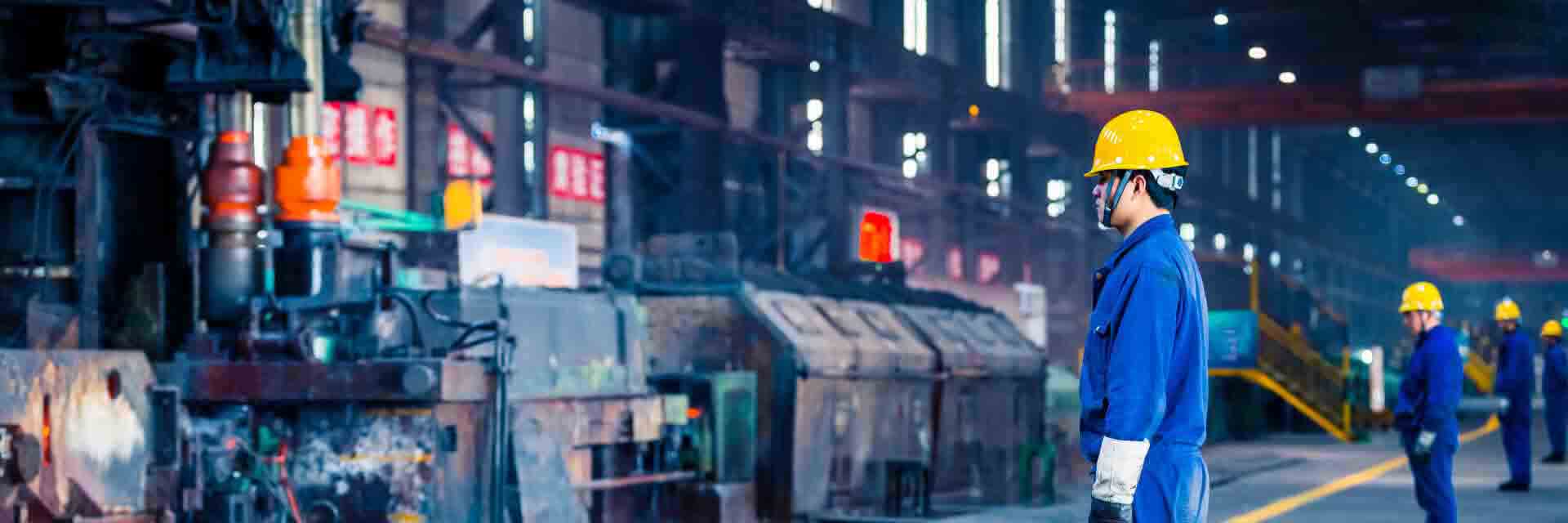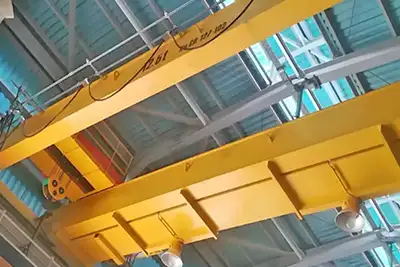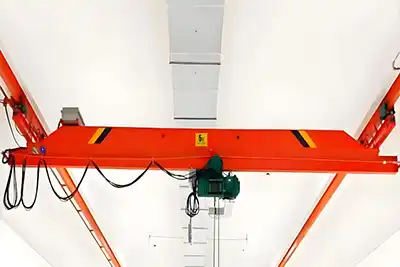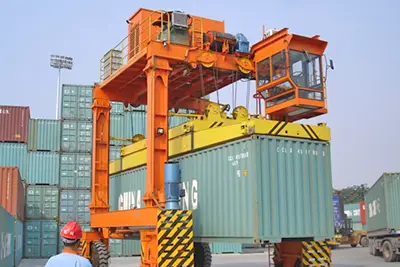Inside Explosion-Proof Bridge Cranes: Cabling, Control, Braking
Explore key design elements ensuring safety and reliability in hazardous areas through specialized cabling, controls, and braking systems.Inside the Design of Explosion-Proof Bridge Cranes: Cabling, Control, and Braking Systems
Introduction: What Are Explosion-Proof Bridge Cranes?
Explosion-proof bridge cranes are special types of overhead cranes. They are built to work safely in hazardous areas where flammable gases, dust, or vapors may be present. Unlike regular cranes, these cranes have extra protections to prevent sparks or heat from causing explosions.
You often find explosion-proof cranes in places like:
- Chemical plants
- Oil refineries
- Grain storage and handling facilities
- Mining sites
These environments are risky because even a tiny spark can cause a serious accident. That’s why explosion-proof cranes are designed with special features to keep everything safe.
Why Explosion-Proof Design Matters
Safety is the top priority in hazardous areas. Explosion-proof design reduces the risk of fire or explosion during crane operation. It protects workers, equipment, and the whole facility.
Here’s why it’s so important:
- Prevents sparks: Components are built or sealed to avoid sparks.
- Controls heat: Parts don’t get too hot to ignite gases or dust.
- Meets strict standards: The design follows international safety rules to ensure reliability.
Without these protections, normal cranes could be dangerous in these settings.
What This Article Covers
This article will take you inside the design of explosion-proof bridge cranes. Specifically, it focuses on three critical systems:
- Cabling: How electrical cables are designed and protected
- Control: How operators safely control the crane in hazardous zones
- Braking: How braking systems are designed to avoid sparks and keep loads secure
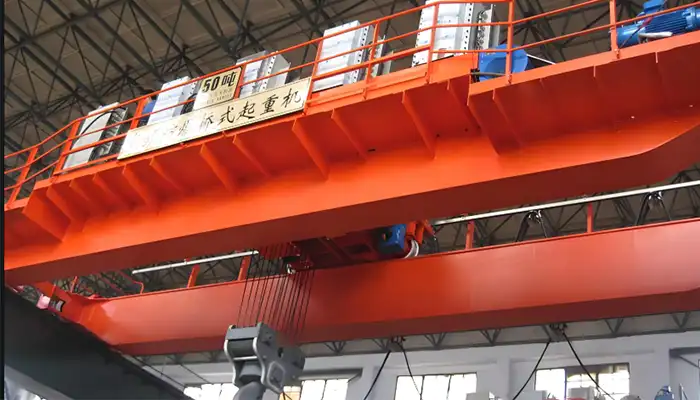
Explosion proof overhead bridge crane for sale 5 ton to 75 ton , affordable price
Overview of Explosion-Proof Bridge Cranes
What Are Explosion-Proof Bridge Cranes?
Explosion-proof bridge cranes are specially designed overhead cranes. Their main goal is to safely operate in areas where flammable gases, dust, or vapors can ignite. The “explosion-proof” part means the crane has built-in features to prevent sparks, flames, or heat from causing an explosion.
These cranes look like regular overhead cranes but have stronger safety measures. They help move heavy loads while keeping the risk of accidents very low.
Where Are They Used? Typical Environments and Applications
Explosion-proof cranes are essential in industries where hazardous materials or atmospheres exist. Some common environments include:
- Chemical plants: Handling corrosive or flammable chemicals safely.
- Oil refineries: Moving heavy parts or materials near volatile gases.
- Grain handling and storage: Dust from grain can be explosive, so cranes must be safe.
- Mining operations: Explosive gases may be present underground or in processing plants.
- Pharmaceutical manufacturing: Areas with flammable solvents and powders.
In these places, safety is critical, and explosion-proof cranes help meet strict safety needs.
Key Standards and Certifications
To ensure safety, explosion-proof cranes must follow recognized standards and get certified by official bodies. These standards guide the design, manufacturing, and testing of cranes used in hazardous areas. Important ones include:
- ATEX (Europe): A set of European directives that ensure equipment is safe in explosive atmospheres. ATEX certification is mandatory for cranes used in the EU.
- IECEx (International): An international certification system focused on explosion protection. It helps manufacturers sell cranes worldwide.
- NEC (National Electrical Code, USA): Defines requirements for electrical installations in hazardous locations, including cranes. It’s widely used in North America.
These standards cover many details, like the type of materials used, wiring methods, and protection types. Complying with them means the crane is tested and proven safe for hazardous environments.
Explosion-Proof Design Principles
General Safety Considerations in Hazardous Zones
Working in hazardous zones means dealing with flammable gases, vapors, or dust. Even a small spark or a hot surface can trigger an explosion. So, safety must be built into every part of the crane.
Key safety points include:
- Avoiding sparks from electrical or mechanical parts
- Preventing hot surfaces that could ignite gases or dust
- Using materials and components that don’t produce static electricity
- Ensuring the crane keeps working reliably, even in tough conditions
Every crane part, from motors to brakes, is carefully designed to reduce these risks.
Types of Explosion Protection Methods
There are several ways to protect equipment in hazardous areas. Crane manufacturers use one or more of these methods based on the environment and needs:
- Flameproof Enclosures (Ex d):
The crane’s electrical parts are sealed inside strong metal cases. If a spark or explosion happens inside, the enclosure contains it so it doesn’t spread outside. - Intrinsic Safety (Ex i):
Electrical circuits are designed to limit energy to levels too low to cause ignition. This method uses special wiring and components to avoid sparks. - Increased Safety (Ex e):
Components are designed and built with extra safety measures to prevent sparks or hot spots but are not sealed. This includes better insulation and robust construction. - Pressurized Enclosures (Ex p):
The enclosure is kept under positive pressure with clean air to stop flammable gases from entering. - Non-Sparking Equipment:
Using parts that cannot create sparks, such as certain metals or coatings, especially in mechanical components like brakes and gears.
How These Principles Influence Crane Design
Explosion-proof design affects nearly every part of a bridge crane:
- Motors and Electrical Systems: Must be housed in flameproof or pressurized enclosures, or use intrinsically safe circuits.
- Cabling and Connections: Use special explosion-proof cables, glands, and connectors.
- Control Systems: Buttons, switches, and panels follow protection types to avoid sparks.
- Braking Systems: Designed to avoid sparks and overheating, often using non-sparking materials.
- Structural Design: Materials chosen to avoid static buildup or sparks, and parts are sealed or protected as needed.
These design principles add layers of safety but also require careful engineering to keep the crane efficient and reliable.
Explosion-Proof Cabling Systems
Why Special Cabling is Needed
Cables in hazardous areas face risks that normal cables don’t. Any damage or fault can cause sparks or overheating, which could trigger an explosion. Because of this:
- Cables must resist physical damage, heat, and chemicals.
- They should prevent flame spread if exposed to fire.
- Installation must avoid creating spark risks.
Common Cable Types for Explosion-Proof Use
Explosion-proof cranes use specific cable types designed for safety:
- Armored Cables:
Metal armor protects against impact and mechanical stress. - Flame Retardant Cables:
Prevent flames from traveling along the cable. - Low Smoke Cables:
Produce less smoke in fires, improving safety and visibility. - Zero Halogen Cables:
Emit no toxic halogen gases when burning, protecting people and equipment.
Cable Glands and Connectors
The entry points where cables meet equipment are critical:
- Must provide airtight, explosion-proof seals.
- Made from materials that do not spark.
- Secure electrical connections firmly.
- Certified to explosion-proof standards like Ex d or Ex e.
Proper Routing and Protection
Good cable routing avoids hazards:
- Keep cables away from sharp edges and moving parts.
- Use trays, conduits, or armor for protection.
- Avoid heat sources that damage insulation.
- Secure cables tightly to reduce wear.
- Prevent accumulation of dust or moisture near cables.
Standards and Testing
Explosion-proof cables comply with:
- IEC 60079 series (International standard for explosive atmospheres)
- ATEX directives (Europe)
- NEC Article 500 (USA)
Before use, cables are tested for:
- Flame resistance
- Mechanical strength
- Electrical safety
Maintenance and Inspection Tips
Regular inspections keep cabling safe:
- Check for cuts, abrasions, or heat damage.
- Ensure glands and connectors are intact and tight.
- Look for moisture or corrosion signs.
- Replace damaged or worn cables quickly.
- Keep thorough maintenance logs.
Explosion-Proof Control Systems
Control Panel Design and Enclosure Requirements
The control panel is the brain of the crane. For explosion-proof cranes, the control panel must be designed to withstand hazardous conditions without risking ignition. This means:
- The panel is housed in a robust enclosure made of metal or heavy-duty materials.
- The enclosure seals tightly to prevent explosive gases or dust from entering.
- It often includes special gaskets and locking mechanisms to maintain the seal over time.
Flameproof and Pressurized Enclosures
Two common types of enclosures protect control panels:
- Flameproof Enclosures (Ex d):
These are built so that if an internal explosion happens, the enclosure contains it and prevents flames or sparks from escaping. The joints and seams are specially designed to cool and stop flames. - Pressurized Enclosures (Ex p):
These keep the inside of the enclosure at a higher pressure using clean air or inert gas. This positive pressure stops hazardous gases from entering, protecting the electronics inside.
Use of Intrinsic Safety Barriers and Isolators
Intrinsic safety (IS) barriers and isolators limit the electrical energy in circuits to prevent sparks or heat. They are often installed between the control system and hazardous area equipment.
Benefits include:
- Allowing safe operation of sensors and controls in explosive zones
- Preventing electrical faults from causing ignition
- Being compact and easy to integrate with control panels
Control Devices and Components Adapted for Hazardous Environments
Explosion-proof cranes use special control components designed for safety and durability:
- Push Buttons and Switches: Made with sealed housings to prevent sparks; often rated for Ex zones.
- Limit Switches: Used to stop crane travel or lifting at set points, built ruggedly to prevent ignition.
- Control Relays: Designed to handle high loads safely without sparking or overheating.
These devices often have certifications showing they meet strict explosion-proof standards.
Automation and Remote Control Options
Modern explosion-proof cranes often include advanced control features:
- Automation: Programmable logic controllers (PLCs) and automated sequences improve precision and safety.
- Remote Control: Wireless or wired remote systems allow operators to control cranes from a safe distance, reducing exposure to hazardous areas.
- Both systems must be designed with explosion-proof or intrinsically safe components.
Redundancy and Fail-Safe Mechanisms
Safety is critical, so control systems often include backup and fail-safe features:
- Duplicate control circuits to take over if one fails
- Emergency stop functions that override all commands instantly
- Mechanical brakes and limit switches to prevent dangerous movements even if the control system fails
These features ensure the crane stops safely in any emergency.
Integration with Crane Monitoring and Diagnostics
Explosion-proof control systems can also be connected to monitoring tools:
- Sensors track crane load, position, and operation status.
- Diagnostics alert operators to faults or maintenance needs before problems grow.
- This integration improves reliability and helps prevent accidents.
Explosion-Proof Braking Systems
The Critical Role of Braking Systems
Brakes are one of the most important safety parts on any crane. They control movement and hold heavy loads steady. In explosion-proof cranes, brakes must not only be reliable but also designed to prevent sparks or overheating—both of which could ignite flammable gases or dust.
A good braking system ensures:
- Smooth stopping and holding of loads
- Prevention of accidental load drops or uncontrolled movements
- Safe operation even in emergency stops
Types of Brakes Used in Explosion-Proof Cranes
- Electromagnetic Brakes:
These brakes use an electric current to engage or release. For hazardous environments, they come with explosion-proof certification to ensure their coils and components do not cause sparks or overheating. They are compact, responsive, and widely used. - Pneumatic and Hydraulic Braking Systems:
These brakes use air pressure or hydraulic fluid to operate. Since these systems don’t rely on electricity for the braking force, they reduce the risk of sparks. Their components are sealed tightly to prevent leaks and contamination in hazardous zones.
Design Considerations to Prevent Spark Generation and Overheating
Preventing sparks is the top priority in brake design for explosion-proof cranes. Some key design features include:
- Using non-sparking materials for brake pads and friction surfaces
- Ensuring smooth engagement to avoid friction sparks
- Designing brake housings that keep dust and gas away from friction parts
- Adding heat dissipation features to prevent overheating during heavy use
All parts are tested to make sure they won’t ignite the surrounding atmosphere, even under heavy load or emergency stops.
Brake Control Integration Within the Explosion-Proof System
Brakes don’t work alone. They are integrated with the crane’s control system for precise operation and safety:
- Braking commands come from explosion-proof control panels or intrinsic safety circuits
- Emergency stop functions automatically activate brakes in critical situations
- Feedback from brake sensors is monitored to detect wear or failures early
This integration helps the crane stop quickly and safely whenever needed.
Maintenance and Testing for Explosion-Proof Brakes
Regular inspection is vital to maintain brake safety and performance:
- Check brake pads and friction surfaces for wear or damage
- Inspect seals and housings for leaks or contamination
- Test electromagnetic coils for correct operation and insulation
- Verify pneumatic/hydraulic lines are tight and free of leaks
- Perform functional tests on emergency stops and automatic brake controls
Maintenance should follow manufacturer guidelines and explosion-proof safety standards. Keeping detailed records helps track brake condition and plan timely repairs.
Challenges and Innovations in Explosion-Proof Crane Design
Balancing Safety and Operational Efficiency
Designing explosion-proof cranes means walking a fine line. Safety is the top priority because these cranes work in risky environments with flammable gases or dust. But at the same time, the cranes need to operate smoothly, efficiently, and with minimal downtime.
Challenges include:
- Making sure all components meet strict explosion-proof standards without adding too much weight or complexity
- Avoiding over-engineering that could slow down crane movement or increase maintenance
- Ensuring that safety features do not interfere with operator control or precision
- Managing costs while using specialized materials and components
Designers constantly seek to strike the best balance between protecting people and property and keeping the crane productive.
Recent Technological Advances in Explosion-Proof Components
The explosion-proof crane industry has seen several exciting advances:
- Improved Materials: New alloys and composites that resist sparks and corrosion better than before.
- Enhanced Enclosures: Lighter, more compact flameproof and pressurized housings that still maintain tight safety margins.
- Energy-Efficient Motors: Motors designed specifically for hazardous zones that reduce heat and energy consumption.
- Modular Components: Parts that are easier to replace or upgrade without breaking safety seals.
These advances help cranes become safer, more reliable, and easier to maintain.
Use of Smart Sensors and Condition Monitoring
Smart technology is making a big impact on explosion-proof cranes:
- Sensors Monitor Load, Temperature, and Vibration: Real-time data helps detect issues before they cause failures or safety hazards.
- Wireless Communication: Intrinsically safe wireless sensors allow remote monitoring without risky wiring.
- Predictive Maintenance: Analytics predict when parts need service, reducing unexpected downtime.
- Integration with Control Systems: Alerts can trigger automatic safety responses or operator warnings.
These innovations improve safety and reduce costs by catching problems early.
Case Studies and Examples of Innovative Designs
- Chemical Plant Crane with Wireless Monitoring: A crane installed with wireless explosion-proof sensors tracked brake temperature and vibration, allowing operators to schedule maintenance before faults developed. This reduced downtime by 30%.
- Oil Refinery Crane with Modular Flameproof Panels: Using modular control panel enclosures made servicing quicker and safer, since panels could be swapped without shutting down the entire system.
- Grain Handling Facility with Low-Weight Explosion-Proof Components: New lightweight materials reduced crane weight, improving speed and energy efficiency without compromising safety.
These examples show how combining smart design and technology can solve real-world challenges in hazardous environments.
Conclusion
Designing explosion-proof bridge cranes takes careful attention to detail—especially in cabling, control, and braking systems. Each part must meet strict safety requirements to prevent sparks, overheating, or failures in hazardous environments.
Following recognized safety standards, like ATEX or IECEx, is not optional—it’s essential for protecting lives and property.
Choosing expert manufacturers and suppliers who understand explosion-proof design inside and out is key. Their experience ensures that cranes are reliable, compliant, and built to perform safely in tough conditions.
In the end, a well-designed explosion-proof crane means safer workplaces and smoother operations, even where risks run high.

